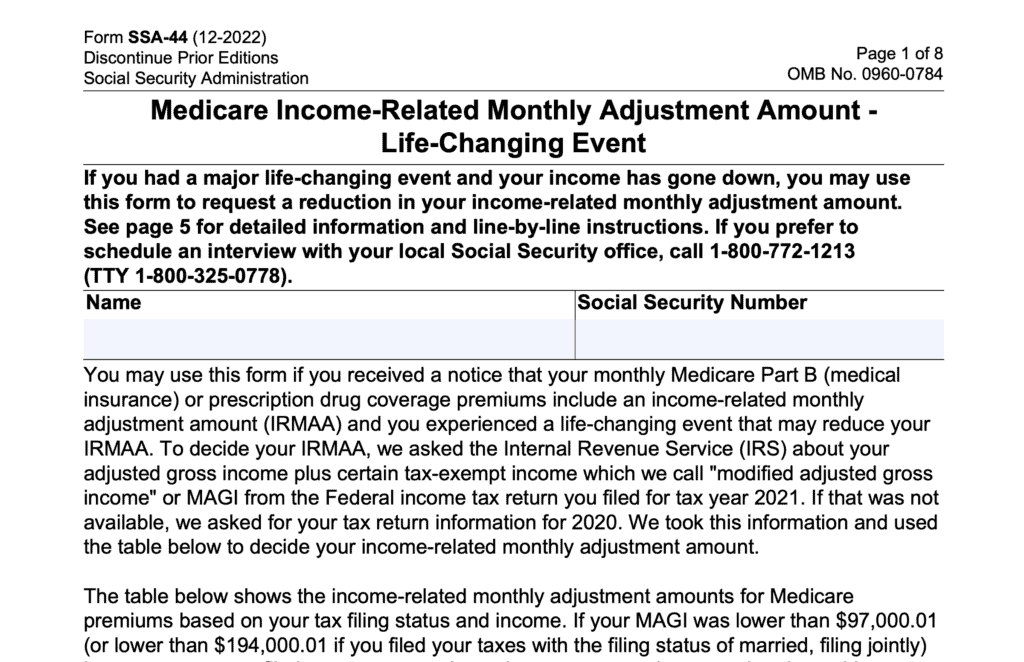Form SSA 10 Instructions
If you are the surviving spouse of a Social Security recipient, you may be eligible for survivor benefits based upon your deceased spouse’s earnings history. To claim spousal benefits, you’ll need to file Form SSA-10, Application for Widow’s or Widower’s Insurance Benefits.
In this article, we’ll walk through each step of this Social Security form and address some frequently asked questions. Let’s start with instructions on completing Form SSA-10.
Table of contents
Video walkthrough
Watch this instructional video to learn more about using Form SSA 10 to apply for widow’s or widower’s benefits.
How do I complete Form SSA 10?
At the top of Form SSA-10, there are a couple of things you should know before going through the application.
First, if you were receiving spousal benefits at the time of your spouse’s passing, then you only need to complete the items that are circled. All other applicants must complete the entire application.
To summarize, the required lines for a surviving spouse receiving benefits includes the following:
- Lines 1-2
- Lines 4-5
- Line 7
- Line 10
- Line 13
- Lines 15-16
- Lines 24-28
Second, if you have not yet reached full retirement age (FRA) and apply for survivor benefits, you may be subject to an earnings test. Before continuing your application, you may want to read How Work Affects Your Benefits, published by the Social Security Administration.
Finally, the Social Security Administration will calculate the amount of your benefits based upon all insurance benefits for which you are eligible. Although you may be applying for benefits based upon your deceased spouse’s history, you may be entitled to higher benefits if you have your own work history or if you qualify for benefits based upon another marriage.
Let’s get started.
Line 1: Decedent’s information
In Line 1a, print the name of the deceased wage earner. This should be as follows:
- First name
- Middle initial
- Last name
For Line 1b, check the appropriate box regarding whether the decedent is a male or female.
In Line 1c, enter the deceased’s Social Security number (SSN).
Line 2: Applicant’s information
In Line 2a, print your name: first name, middle initial, last name.
For Line 2b, enter your SSN.
In Line 2c, enter your name as it appears on your birth certificate, if this name is different from the one listed in Line 2a. This commonly happens to married spouses who may have a different maiden name.

Line 3: Decedent’s date of birth
Enter the deceased person’s date of birth in Line 3.
Line 4: Date and place of death
In Line 4a, enter the date that the decedent passed away. For Line 4b, enter the city and state where he or she died.
Line 5: State of residence
If applicable, enter the name of the state or foreign country where the deceased person had a permanent home at the time of death.
Line 6: Application history
In Line 6a, check ‘Yes’ or ‘No’ about whether the decedent ever applied for any of the following:
- Social Security benefits
- Can be retirement benefits, disability benefits, or survivor benefits
- Period of disability under Social Security
- Supplemental Security Income (SSI)
- Medicare health benefits
If the answer is ‘No,’ proceed to Line 7. Otherwise, go to 6b.
For Line 6b, enter the name of the person on whose Social Security record the deceased filed their other application.
In Line 6c, enter that person’s Social Security number, if known. If you do not know the SSN, check the appropriate box.

Line 7: Did the decedent have a disability?
Do not answer Line 7 unless:
- The deceased died before reaching full retirement age (FRA), OR
- Prior to 1 year beyond FRA, AND within the past 4 months
In Line 7a, check ‘Yes’ if the decedent was unable to work because of illness, injury, or other health conditions at the time of his or her death. In Line 7b, enter the date that the decedent became unable to work.
Otherwise, check ‘No’ in Line 7a, and go to Line 8.
Line 8: Decedent’s military service history
If the decedent never served in the military, check ‘No,’ then go to Line 9, below. If the decedent was on active military orders (even as a reservist) at any point after September 7, 1939 and before 1968, then check ‘Yes’ and go to Line 8b. If the decedent’s military occurred in 1968 or later, then check ‘No’ and go to Line 9, below.
In Line 8b, enter the dates of service (month and year only)
For Line 8c, check ‘Yes’ if anyone received or expects to receive benefits from any other federal agency, including disability benefits from the Department of Veterans’ Affairs.

Line 9: Decedent’s earnings
Do not answer Line 9 if the decedent passed away more than 2 years ago.
For Line 9a, enter the approximate amount that the decedent earned in the year of his or her death. This includes both employment earnings and any self-employment income the decedent may have had.
In Line 9b, enter the approximate earnings amount for the year before the decedent’s death.
Line 10
In Line 10a, check ‘Yes’ if the deceased had wages or self-employment income that were covered under Social Security for all tax years between 1978 and last year. Then skip to Line 11, below.
Otherwise, check ‘No’ and list the years in which the deceased did not have wages or self-employment income in Line 10b.
Line 11
If you do not plan to submit documentation or other evidence regarding the decedent’s earnings for the past 2 years, check the box. If you do plan to include substantiating documentation, skip to Line 12, below.
Whether you submit any documentation, the SSA will evaluate Social Security benefits as the decedent’s earnings record continues to be updated. Normally, this is as a result of federal income tax return information that eventually is reported to the SSA.
As the earnings record is updated, you can expect to receive any benefits increase automatically, without additional paperwork. The SSA will apply any increase in your benefits retroactively.

Line 12: Deceased’s Marriage
Only answer Line 12 if the decedent had other marriages, either prior to or after his marriage to you. If the decedent remarried after the marriage between you ended, enter the information on the most recent marriage here.
If there are no other marriages, proceed to Line 13.
In Line 12a, include:
- Spouse’s name (including spouse’s maiden name)
- Date and location of marriage date
- How, when, and where the marriage ended
- Whether the marriage ceremony was performed by a clergyman, public official, or other person
- If someone other than a clergyman or public official conducted the marriage, provide a written explanation in the remarks section.
- Spouse’s Social Security number, if known
- If not known or there is no SSN, indicate this as well
For Line 12b, enter information about any other marriages that meet the following criteria:
- Marriage lasted 10 years or longer
- Marriage ended in divorce, but the decedent remarried the same person within the year immediately following the year of divorce, and the combined marriage periods exceeded 10 years
- Marriage ended in the death of the spouse, regardless of how long it lasted
For third and subsequent marriages, use the remarks section to provide additional information.
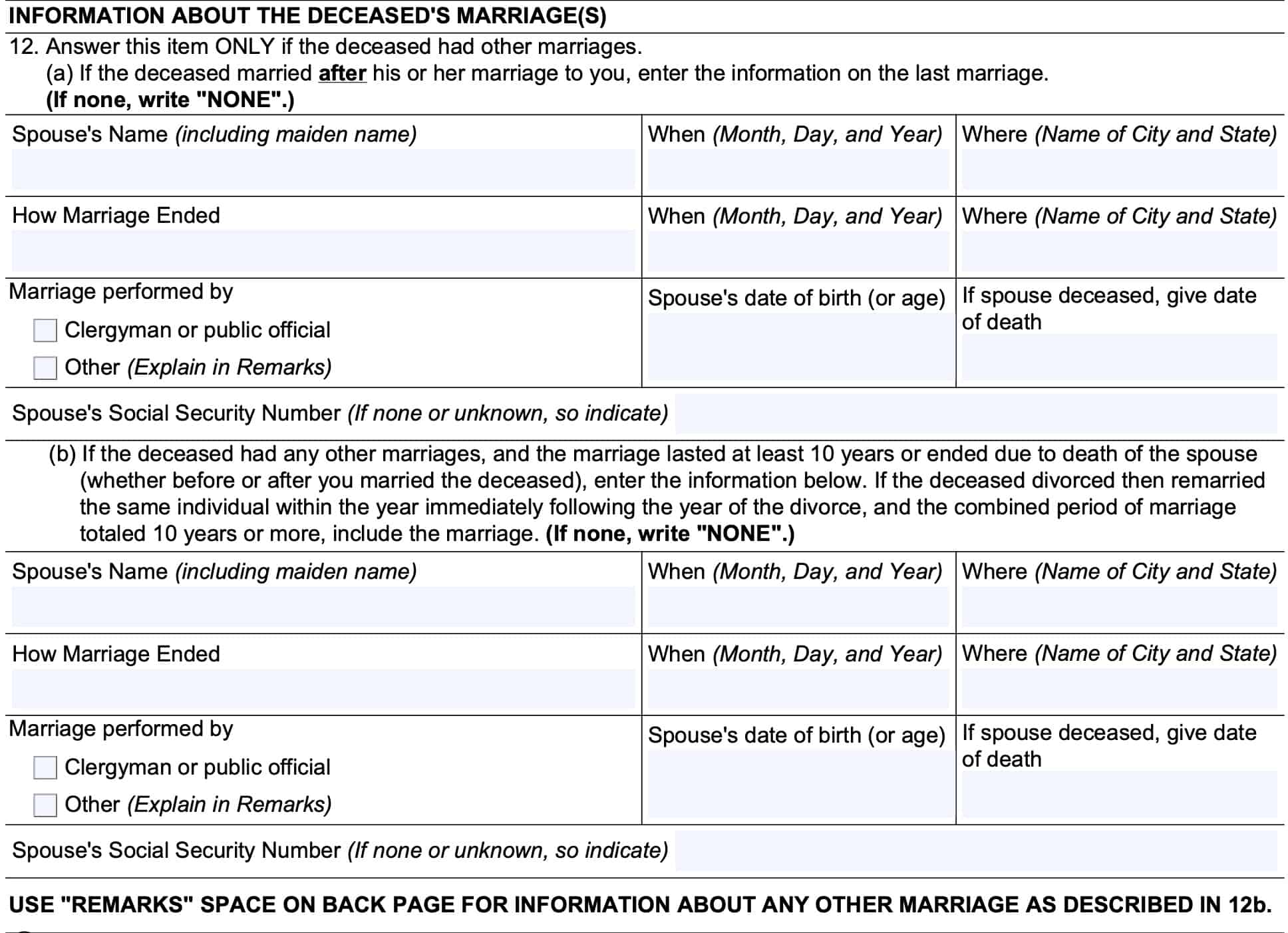
Line 13: Surviving parent information
Check ‘Yes’ if there is one or more surviving parents who were receiving support from the decedent at the time of death or disability as defined by the Social Security Act. Enter the name and address of surviving parents in the remarks section.
Otherwise, proceed to Line 14.
Line 14: Applicant’s information
In Line 14a, enter the name of the state or foreign country where you were born.
For Line 14b, check the appropriate box to indicate whether there was a public record of your birth made before the age of 5. This can be a birth certificate or consular report of birth abroad for U.S. citizens born in a foreign country. If the answer is ‘Yes,’ proceed to Line 15.
In Line 14c, indicate whether there was a religious record of your birth before the age of 5.

Line 15: Information about your marriage
In Line 15a, enter information about your marriage to the decedent. Similar to Line 12, this should include:
- Spouse’s name (including spouse’s maiden name)
- Date and location of marriage date
- How, when, and where the marriage ended
- Whether the marriage ceremony was performed by a clergyman, public official, or other person
- If someone other than a clergyman or public official conducted the marriage, provide a written explanation in the remarks section.
- Spouse’s Social Security number, if known
- If not known or there is no SSN, indicate this as well
If you remarried after your marriage to the decedent, complete Line 15b to include information about the last marriage. If not applicable, simply write ‘None.’
In Line 15c, enter any information about other marriages (before or after your marriage to the decedent) that meets the following guidelines:
- Marriage lasted 10 years or longer
- Marriage ended in divorce, but the decedent remarried the same person within the year immediately following the year of divorce, and the combined marriage periods exceeded 10 years
- Marriage ended in the death of the spouse, regardless of how long it lasted
If you need more space for additional marriage information, go to the remarks section.
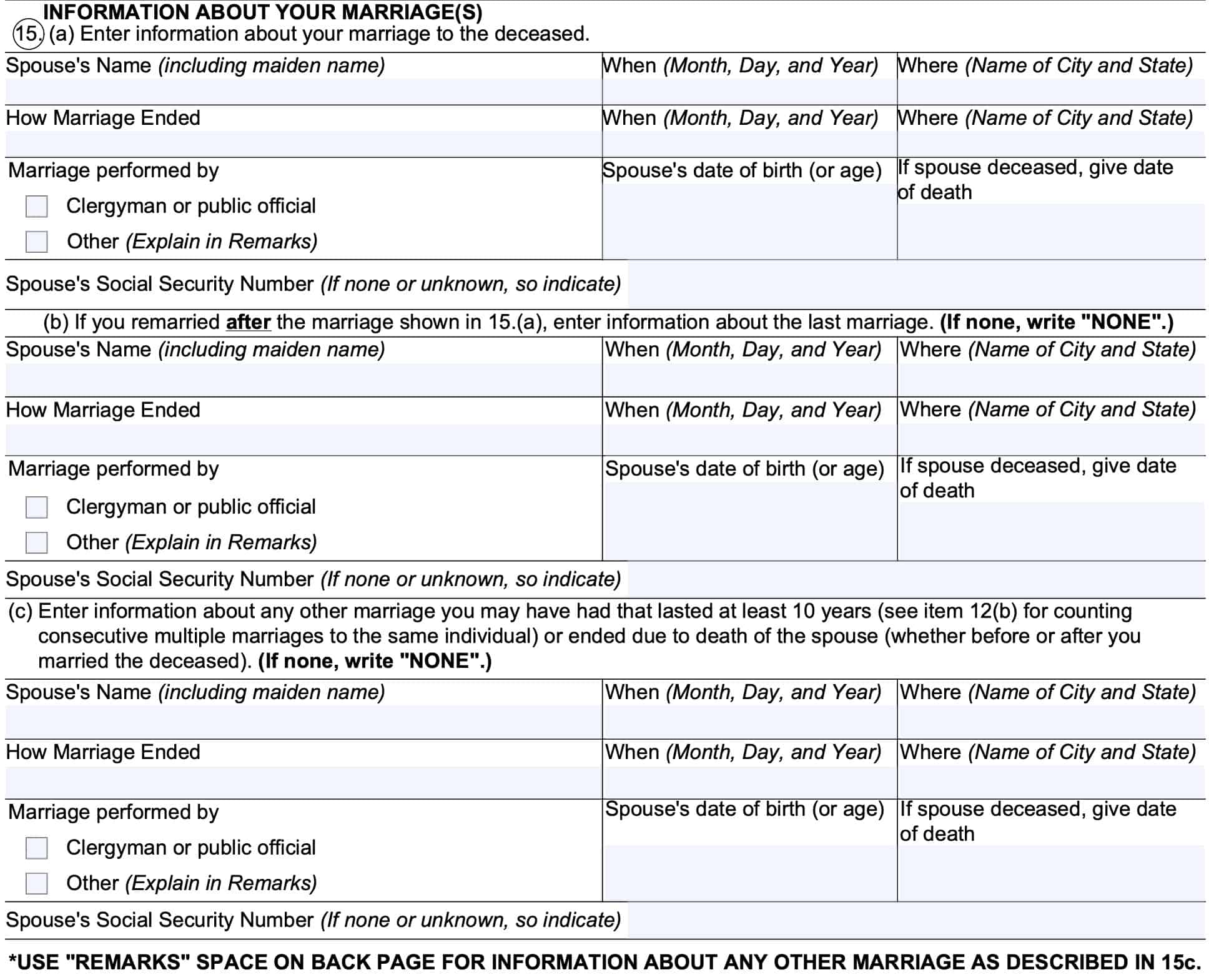
Line 16
If you’re applying for survivor benefits based upon a divorced spouse’s work history, skip Line 16 and proceed directly to Line 17, below.
Line 17
In Line 17a, check ‘Yes’ if you, or anyone on your behalf, have ever filed an application for any of the following:
- Social Security benefits
- Social Security disability insurance
- Supplemental Security Income
- Medicare health benefits
Otherwise, check ‘No’ and go to Line 18, below.
In Line 17b, enter the name of the person on whose record you filed any other application. In Line 17c, enter the Social Security number of the other person.

Line 18: Disability history
Do not answer Line 18 if you have already reached full retirement age (FRA). Simply go to Line 19, below.
If you have not reached FRA, and you’ve been unable to work within the past 14 months due to an illness, injury, or other medical condition, check ‘Yes.’ Otherwise, check ‘No’ and proceed to Line 19.
In Line 18b, enter the date that you became unable to work.
Line 19: Military service
If you were ever on active duty after September 7, 1939, and before 1968, check ‘Yes.’ Otherwise, check ‘No.
Line 20: Railroad industry history
If either you or the decedent worked in the railroad industry for at least 5 years, check ‘Yes.’ Otherwise, check ‘No.’
Line 21: Other country social security system
In Line 21a, if you or the deceased have Social Security credits under another country’s Social Security system, check ‘Yes,’ then list the country or countries in Line 21b. Otherwise, check ‘No.’
Line 22: Pension information
Do any of the following apply to your situation:
- You have qualified for, or expect to qualify for a pension or annuity
- Based on your own employment and earnings
- For the federal government or a state or local government
- Not covered under Social Security
If the answer is yes, then select ‘Yes’ and go to Line 22b. Otherwise, select ‘No’ and go to Line 23.
In Line 22b, check the appropriate box regarding your pension or annuity. If you have not yet applied for your pension benefits, enter the approximate date that you expect to start receiving benefits. If that date is unknown, enter ‘Unknown.’
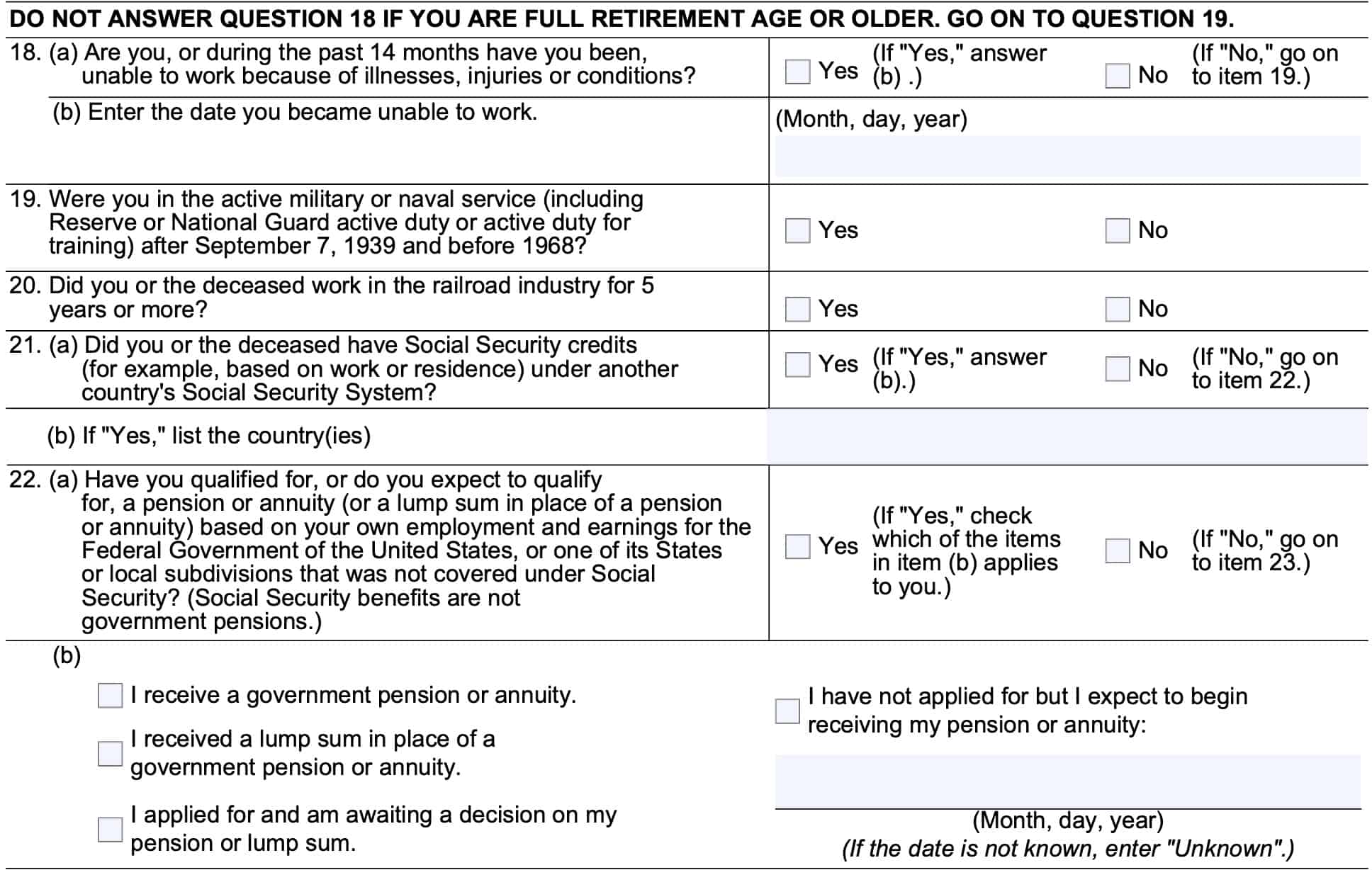
Line 23: Medicare information
In Line 23, check the appropriate box, depending on whether you want to use this application form to apply for Medicare insurance. However, skip this box if you are younger than age 65, and you do not expect to turn 65 within the next three months.
About Medicare
If you are eligible for Medicare and have not already applied for Medicare benefits, you may want to discuss this further with your local SSA office. Generally, additional fees may apply to your Medicare premium as a late enrollment penalty for Medicare recipients who do not apply when eligible.
This higher premium is a permanent increase to your Medicare costs.
Additionally, there is an initial enrollment period for people turning age 65. This window includes the following
- Three month period prior to turning age 65
- The month the applicant turns age 65
- Three month period after turning 65
Late applicants who miss the deadline may have to wait until the next Medicare enrollment period. This is usually between January 1 and March 31 of each calendar year.
There may be certain exceptions for people who are still working and participating in a group health plan. This exception extends to a spouse covered under the health care plan. After those individuals stop working, there is a special enrollment period window for application. The special enrollment period is 7 months.
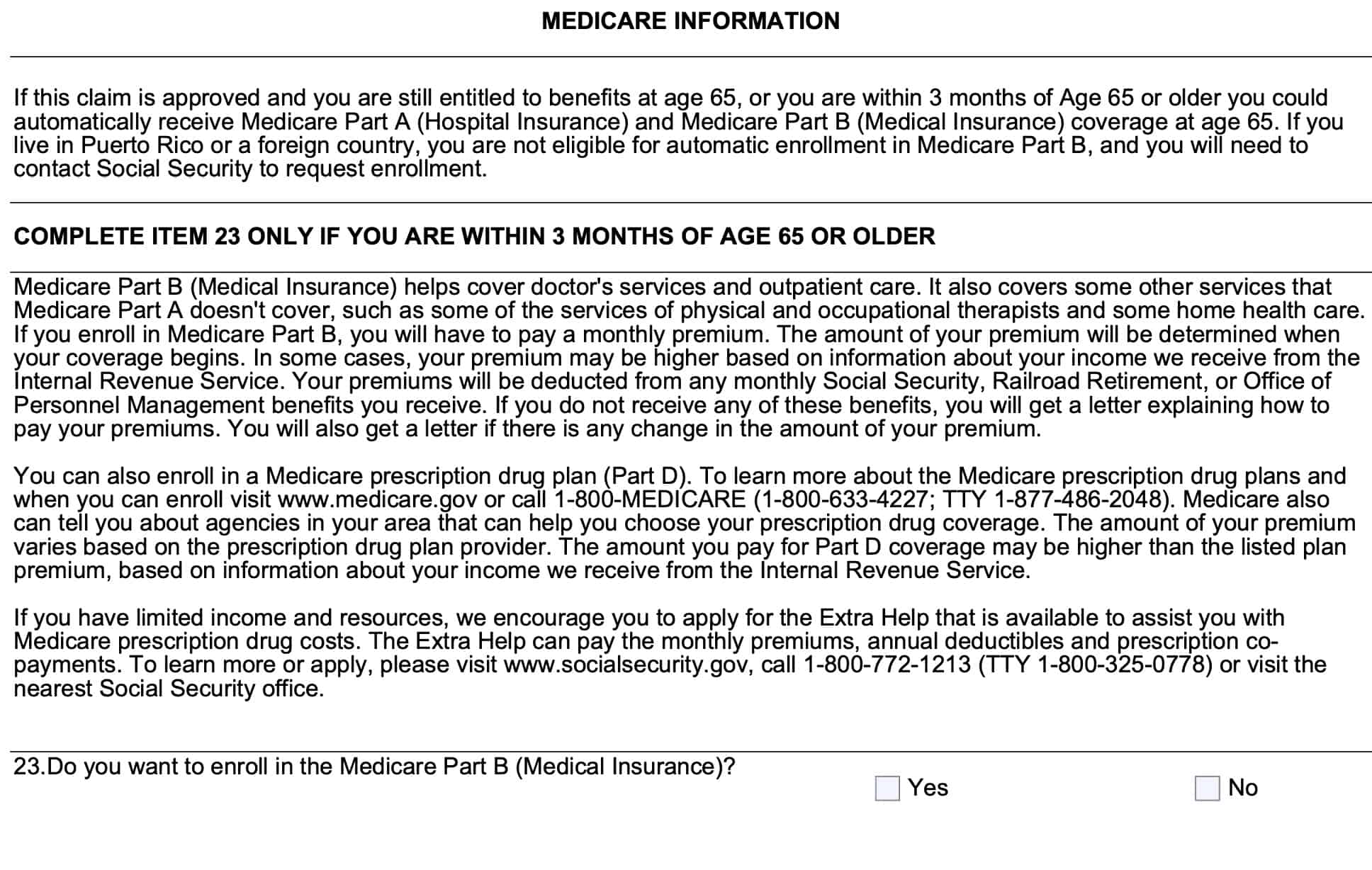
Line 24: prior year earnings information
Lines 24 through 26 mostly impact recipients who may be younger than full retirement age, and could be subject to an earnings test.
Do not answer Line 24 if the decedent passed away before the beginning of this year.
In Line 24a, enter how much your total earnings were from last year. This should not be the number from your income tax return. This should be the total of your employment earnings, either as an employee or as a self-employed individual. You should be able to find evidence of your earnings from wage statements, tax records, or paystubs.
In Line 24b, you’ll need to determine the monthly exemption for earnings. In 2023, the annual earnings limit for people younger than FRA is $21,240. This translates to a monthly limit of $1,770.
If there were any months in which you earned less than $1,770, then check the appropriate box(es). If there were no months where you earned less than $1,770, check the ‘None’ box. If you earned less than $1,770 in all months during the tax year, then check the ‘All’ box.
Line 25: Current year earnings information
In Line 25a, enter your expected earnings for the current tax year.
For Line 25b, follow the same steps that you did in Line 24b.
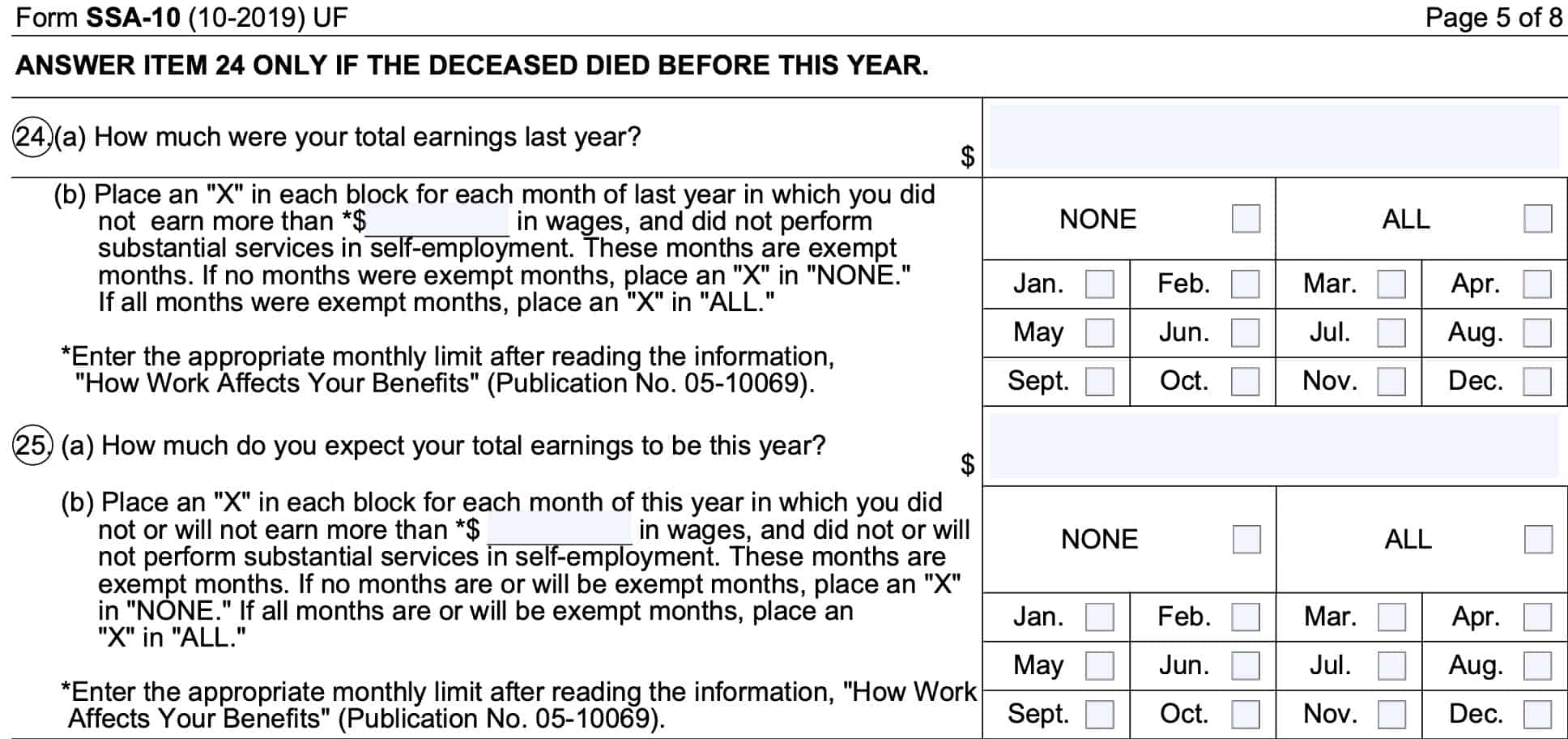
Line 26: Next year’s earnings
Do not answer Line 26 if you are completing this application between January and August of any calendar year.
If you’re completing this application in September, October, November, or December, then enter your projected earnings for next year in Line 26a. Then follow the steps in Line 26b as you did for Lines 24b and 25b.
Line 27: Fiscal year
If your fiscal year is the same as your calendar year, leave this field blank and go to Line 28. Otherwise, enter the month in which your fiscal year ends.
If you are not sure, but your income tax return is normally on or around April 15, then you can leave this field blank.

Line 28
If you have already reached FRA, you can skip to Line 29, below. Otherwise, check the box that indicated your preference:
- You’d like to receive your survivor benefits as soon as possible
- You want to maximize your benefits, even if you need to wait an extra month or two
- You have a specific date in mind
If you do not wait until reaching FRA for your benefits, your monthly benefits may be lower than expected. Please consider this carefully before making your decision.
Line 29
Do not answer Line 29 if you are younger than age 62 and do not expect to turn 62 within the next 4 months.
If you wish to apply for retirement benefits based upon your earnings record, check ‘Yes.’ Otherwise, select ‘No.’

Remarks
The remarks section may. be used to provide a written explanation or additional information for any field where you did not have enough room in the space provided.
As a suggestion, for each explanation, write the line number next to the verbiage. Attach additional sheets as needed.

Direct deposit information
In this section, you’ll enter the account information for the financial institution where you would like to receive your Social Security benefits. Include the following information:
- Routing Transit Number
- This is the 9-digit number on the bottom, left hand side of any checks you may have
- Each financial institution has a unique routing transit number
- Account Number
- This is unique to your checking or savings account
- Check whether your account is a checking or savings account
- Check whether you’re enrolling in Direct Express or if your direct deposit request has previously been refused

Applicant signature
In this field, you’ll sign your name in ink, then enter the application date and a contact telephone number. This number should be where an SSA employee can call you during the day to answer any questions.
Below this, enter your mailing address, to include:
- Street address or P.O. Box number
- City & state
- Zip code
- Country (if residing outside the United States)
You do not need to have witnesses unless you sign ‘X’ as the applicant. In that case, you will need two witness signatures and addresses from people who personally know you and can verify your identity.

Claim receipt
When you file your Form SSA-10, you should receive a receipt from the SSA office. This claim receipt will contain the following information:
- Contact information to call before you receive a notice of award
- Contact information to call after you receive a notice of award
- SSA office handling your claim
- Date of receipt
- Approximate number of days the SSA should take before giving you a response
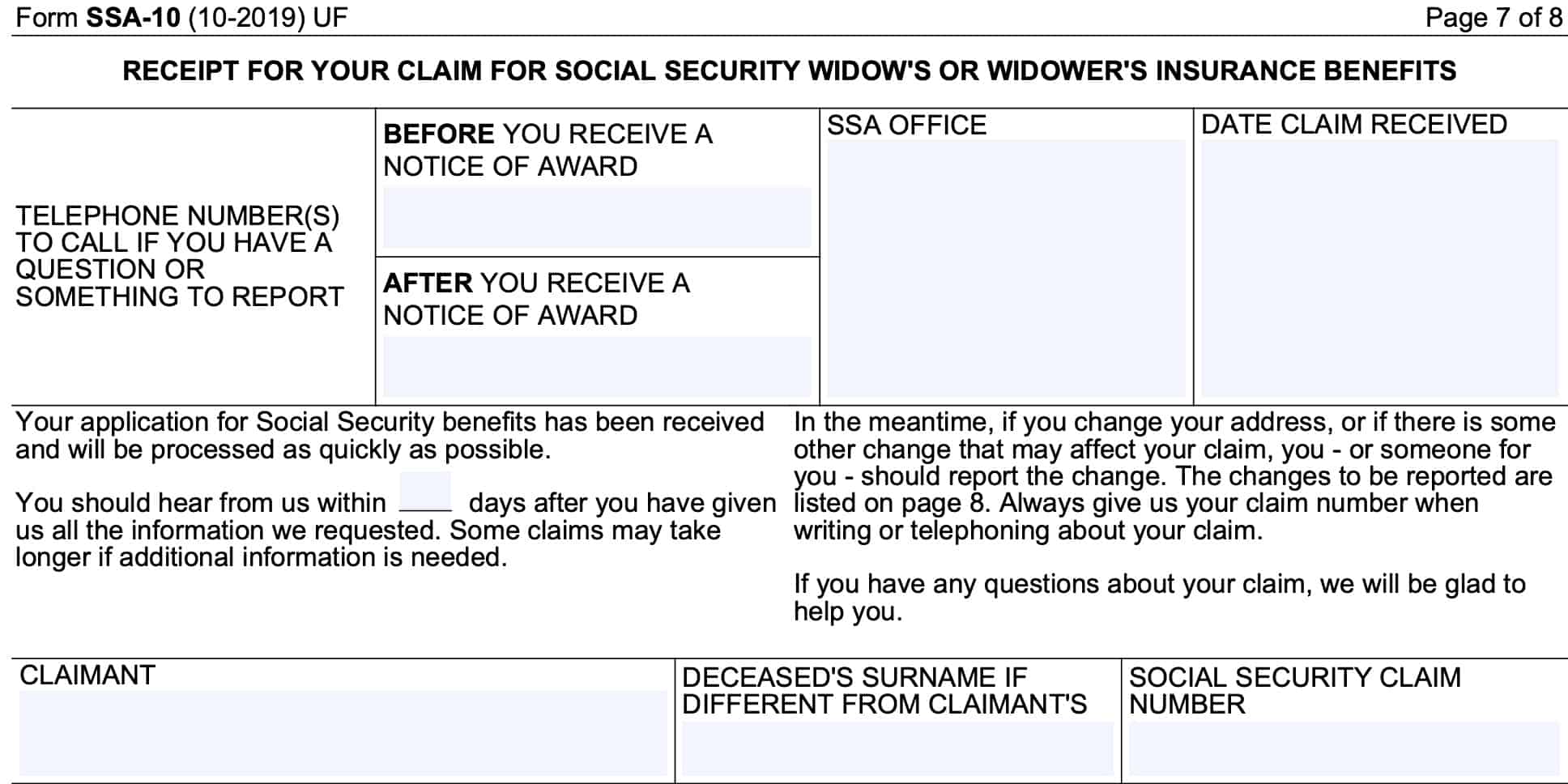
Frequently asked questions
You may file for spousal benefits over the phone by calling the SSA’s toll-free number: 800-772-1213. To protect sensitive information, you may need to file Form SSA 10 in person at your local Social Security office.
Survivor benefits will continue to be paid until the recipient dies or becomes eligible for a larger benefit based upon either their own earnings record, or the earnings record of another spouse.
Eligible spouses may be eligible to receive survivor benefits as early as age 60. However if you delay filing Form SSA 10, you may be eligible for larger monthly benefits when you do file. Delayed benefits increase until full retirement age. Spouses who wait until FRA to claim survivor benefits will receive a larger monthly payment than if they filed at their first opportunity.
Direct Express is a program that enables Social Security recipients to receive benefits without having a bank account. Social Security payments are loaded onto a Direct Express MasterCard instead of deposited into an account. Recipients may use their card to make purchases, pay bills, or withdraw cash from an ATM.
Where can I find Form SSA-10?
As with many other SSA forms, you may find a copy of this form on the SSA website. For your convenience, we’ve attached the latest version to this article.



